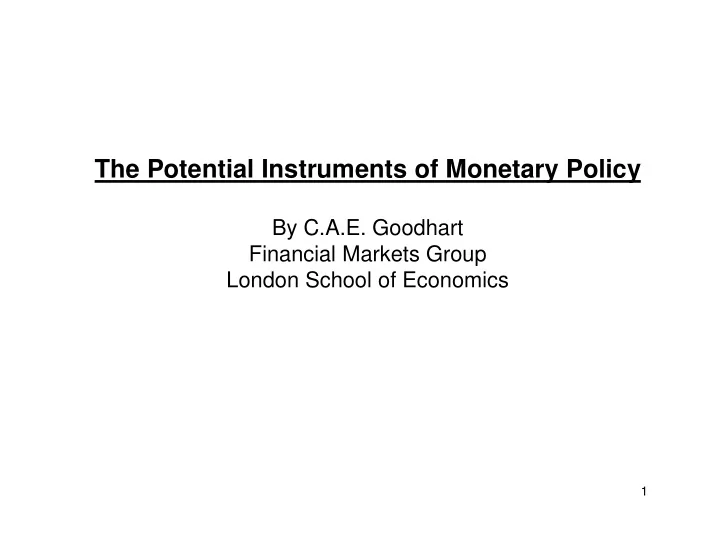

The Potential Instruments of Monetary Policy By C.A.E. Goodhart Financial Markets Group London School of Economics London School of Economics 1
Introduction Standard DSGE models assume that no one ever defaults (e.g. transversality condition). So everyone can borrow, or lend, at single riskless interest rate. No risk premia, no financial intermediaries, (banks), (and no money). Central Bank sets short rate, via reaction function. Only degree of freedom is expectation of future policy rates, Woodford (Jackson Hole, 2012) and expectations of inflation. But are such future forecasts 1) Credible (BoJ and inflation)? 2) Desirable? 2
The Money Multiplier M = D + C H = R + C So M = H (1 + C/D) (C/D + R/D) But which way did causation go? If CB sets interest rates (i), then it has to provide banks with enough R to validate chosen level of i. M = f (Y, i, Bank profitability, etc.) So Money Multiplier determines H. No longer true when i � 0. H can then be independently set, e.g. by QE. 3
Historically money multipliers reasonably constant over time, at about 10. Once QE starts they collapse to less than 1. Tiny multipliers (PNFCs and the Household sector), per cent Change in June 2008 to June 2009 Change in Bank Change in Bank Lending (For Japan: March 2001 (For Japan: March 2001 Reserves Held Reserves Held Broad Money Broad Money to Private to Private to March 2006) at Central Bank Sector UK 371 2 1 USA 1853 9 4 Eurozone 122 4 2 Japan 103 8 -17 Source: Goodhart, et al. (2009). 4
Key assumption of money multiplier has been that banks are (generally) liquidity constrained. Rarely true, not true now. Instead banks will expand assets, and hence money, if it enables them to meet desired RoE. Why RoE? So bank lending depends on:- Equity requirement (CAR) S↓ Target RoE on equity requirement Target RoE on equity requirement S↓ S↓ Funding cost of residual debt S↓ (Bk funding cost at a variable spread over official rate) Achievable spread over funding cost S↓ D↓ Probability of Default S↓ 5
Bk lending to public sector Equity requirement = 0 PD = 0 for full sovereigns So such lending should expand if:- Expected Return > Expected Funding Cost Expected Return > Expected Funding Cost 6
Bank of England Base rate and 2-year and 10-year bond yields 10 9 2-year bond yield base rate 8 10-year bond yield 7 6 5 4 3 2 1 0 Feb/94 Jun/95 Oct/96 Feb/98 Jun/99 Oct/00 Feb/02 Jun/03 Oct/04 Feb/06 Jun/07 Oct/08 Feb/10 Jun/11 Source: Ashworth and Goodhart, Haver Analytics So bank deposit rate sets the floor for public sector rates. 7
This should provide us with another instrument. 8
Could one make deposit rate negative? Anti: • Fairness • Profitability • Other money market operations • Currency as an alternative But Divorce average from marginal. 9
A public sector bank? No • Take too long • Recipient of refused (lemon) projects • Objectives unclear • Objectives unclear • High losses • Lower comparative returns (unfair competition) • Corruption and political direction 10
How to Encourage more lending to Private Sector: 1) Reduce CAR (not likely) 2) Lower borrower PD (guarantees? Part loss? A good deal for taxpayer?) 3) Lower funding costs (FLS, others) 4) Force down ROE by threatening to inject new equity into bank whose lending is growing too slowly. Akin to TARP, but should it be done? 11
Recommend
More recommend